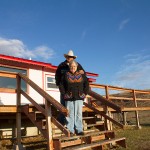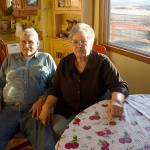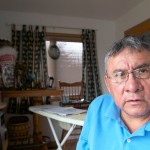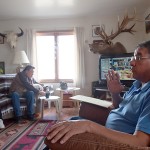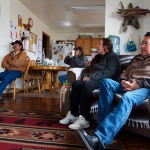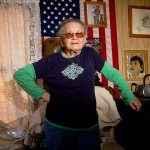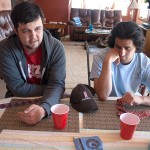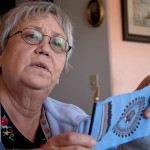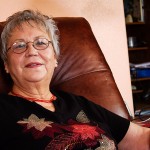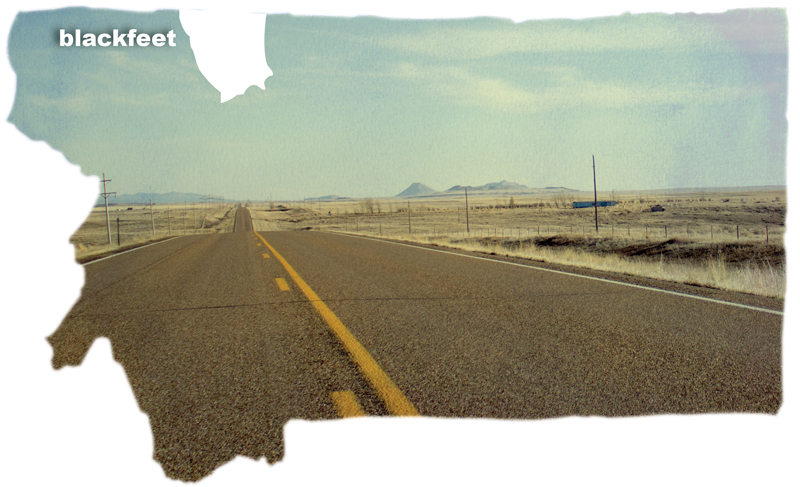Blackfeet
Blackfeet – Fractioned Identity
- Truman Hall and his wife, Joy, stand outside their home on the Blackfeet reservation. Both are enrolled members of the Blackfeet tribe and lease the land on which their ranch sits. The couple hopes to leave it to their grandson one day, but with the current blood quantum requirements, their grandson isn’t able to enroll.
- Truman Hall and his wife, Joy, are enrolled members of the Blackfeet tribe and own their ranch land. The Halls’ hope one day they’ll be able to leave their land to their grandson, Seth Hall. Seth is a descendent of the Blackfeet tribe, but if enrollment requirements changed, he would become an enrolled member and have right to his grandparents’ land.
- Gabe Grant is an enrolled member of the Blackfeet tribe and an active member of the Blackfeet Against Open Enrollment group. The main goal of the group is to keep the current blood quantum requirement in place.
- Clyde Home Gun, rancher and enrolled member of the Blackfeet tribe, opposes changing the enrollment policy. As a member of Blackfeet Against Open Enrollment, he feels letting descendants enroll would decrease tribal finances.
- Gabe Grant speaks to the Blackfeet Against Open Enrollment group at his home in Browning. The group has no official leader but meets to discuss the current enrollment debate.
- The Blackfeet Against Open Enrollment group meets at the home of Gabe Grant and discusses why opening enrollment would hurt the tribe. The group is fighting to keep the current enrollment requirement because they feel the tribe will lose funds if more people are allowed to enroll.
- Omie Crawford is an enrolled member of the Blackfeet tribe and lives in Heart Butte. She is a supporter of the Blackfeet Enrollment Amendment Reform group and wants the enrollment requirements to change from blood quantum to lineal descent.
- Sterling Holy White Mountain, left, and Robert Hall discuss why it is necessary to change the tribal enrollment policy. Both men are descendants of the Blackfeet tribe and active members of the Blackfeet Enrollment Amendment Reform group. If enrollment requirements change from blood quantum to lineal descent then both will be eligible for enrollment.
- Linda Juneau holds up a small replica of the Blackfeet tribe’s flag during a Blackfeet Enrollment Amendment Reform meeting. The group has been banned from using tribal facilities to meet, so they hold their meetings at a member’s home.
- Linda Juneau is an enrolled member of the Blackfeet tribe and an active member of the Blackfeet Enrollment Amendment Reform group. The group was formed in February 2012, and their main goal is to change the requirement for enrollment.from blood quantum to lineal descent. This would make Blackfeet descendants eligible to become enrolled tribal members and receive benefits only afforded to enrolled members.
Story by HANAH REDMAN
Photographs by STACY THACKER
There is no future for Seth Fenner on the Blackfeet Nation.
Seth Fenner can’t inherit the house he grew up in. The house that sits on the same land where his great-grandparents are buried. It’s where his grandparents, Truman Hall and wife Joy, raised three children and many grandchildren, and it’s where they still live and ranch.
Once Fenner’s grandparents are gone, Fenner won’t be allowed to use the tribal land he is ranching. He won’t get employment preference on the reservation. He could be left with no options but to leave his home, his roots.
Fenner uses Hall’s land and leases to run his ranch and make a living on the Blackfeet reservation—land and leases he can’t get on his own, because he is not an enrolled member of the tribe.
“He can’t run his cattle, he can’t inherit our mutual home or tribal land, because he doesn’t have a tribal enrollment card,” Hall said.
The bed of an old, horse-drawn wagon sits at the entrance to the property with the words “Hall Ranch” and “Home Sweet Home” painted on it in white. It’s a cozy home in the country on the Blackfeet Indian Reservation. It’s full of pictures of his family, going all the way back to the early 20th century.

Truman Hall and his wife, Joy, stand outside their home on the Blackfeet reservation. Both are enrolled members of the Blackfeet tribe and lease the land on which their ranch sits. The couple hopes to leave it to their grandson one day, but with the current blood quantum requirements, their grandson isn’t able to enroll.
Hall and his wife are both enrolled members of the tribe, and all three of their daughters are enrolled, too.
In 1962, the Blackfeet tribal council amended the constitution to include a blood quantum-based enrollment policy. Now, anyone born after Aug. 30, 1962, looking to enroll as a member of the Blackfeet tribe must prove they are one-quarter Blackfeet by lineage. This means an enrolled citizen must have at least—or the equivalent of—one full-blooded Blackfeet grandparent to barely meet the quantum criteria.
In the past year, a movement challenging the blood quantum requirements has created a rift throughout the tribe, polarizing citizens and challenging the very definition of Blackfeet identity. Supporters and opponents argue that a change to the current policy could affect the reservation on several levels, from political to financial.
Fenner doesn’t have enough Blackfeet blood in him, by the tribe’s standards, to be enrolled. It’s a question of identity his grandmother remembers puzzling Fenner as a child.
She remembers Fenner asking her, “Grandma, I’m dark as Grandpa. How come I can’t be an Indian?”
The Blackfeet tribe has considered changing the enrollment policy before. In 1994, the tribal council petitioned the Bureau of Indian Affairs to change to a model based on lineal descent: If your parents are enrolled, so are you. The reply quickly shot down further discussion of the matter.
The BIA responded to the request with a letter warning the tribe that eliminating blood quantum as a measure of tribal enrollment could blur, or even eliminate, the relationship tribal members have with the tribe. As a result, this could endanger the Blackfeet Nation’s federal recognition.
“A tribe does not have authority under the guise of determining its own membership to include as members persons who are not maintaining some meaningful sort of political relationship with the tribal government,” the letter states.
It goes on to say that the Department of the Interior is “extremely reluctant” to approve an amendment that would jeopardize that relationship. It warns that if Native American tribes fail to demonstrate a measurable relationship between the tribe and its members, “the courts or Congress may well decide that a tribe has so diluted the relationship between a tribal government and its members that it has ‘self-determined’ its sovereignty away.”
Now, nearly 20 years later, the issue of blood quantum has risen once again with a vocal group pushing a plan to change the tribe’s enrollment policy to one that would mirror the lineal descent model considered in the mid-1990s. Supporters of the plan say the enrollment policy would be more inclusive of descendants and essentially validate their tribal identity. Opponents say such a move would be financially catastrophic and could possibly result in the loss of the entire reservation.
In February 2012, Blackfeet Enrollment Amendment Reform, a group of enrolled and un-enrolled tribal members, proposed the tribe abandon the idea of blood quantum and instead adopt a policy of lineal descent for up to three generations. Any individual whose parents, grandparents or great-grandparents were enrolled Blackfeet could enroll.
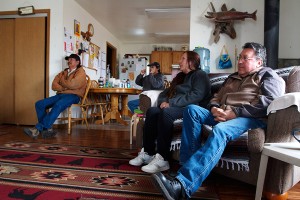
The Blackfeet Against Open Enrollment group meets at the home of Gabe Grant and discusses why opening enrollment would hurt the tribe. The group is fighting to keep the current enrollment requirement because they feel the tribe will lose funds if more people are allowed to enroll.
Another group opposes the change in enrollment policy: Blackfeet Against Open Enrollment. The two groups clashed in rallies, protests and confrontations last summer.
There are a little more than 17,000 enrolled Blackfeet members and approximately 3,000 registered descendants, according to estimates from the Blackfeet Tribe Enrollment Office. However, not all descendants of the tribe register with the enrollment office, so there could be many more living on or off the reservation.
Those against changing the policy say lack of a blood quantum requirement would eventually destroy the reservation, using the BIA response saying that doing so could result in the Blackfeet tribe losing its tribal status.
George Calftail, an opponent of changing the enrollment policy, holds a bleak and cynical view. He said he fears that once people who have no genetic connection to the Blackfeet tribe become enrolled and hold positions of power, they’ll be more likely to sell out and terminate the reservation once they find out there’s no money for them.
“We’re fighting to stop things like this, and to try to preserve our land, to preserve the culture, to preserve what we are,” Calftail said. “And if they open the rolls, that’s what’s going to happen. We’re going to cease. You’ll just read about us in a book.”
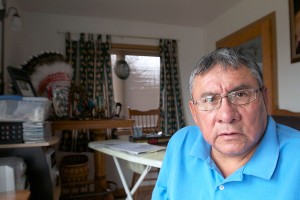
Gabe Grant is an enrolled member of the Blackfeet tribe and an active member of the Blackfeet Against Open Enrollment group. The main goal of the group is to keep the current blood quantum requirement in place.
Supporters of changing the system share the same fear of losing the reservation. Hall, whose grandson can’t inherit his land because he is leasing it from the tribe, is worried that as the number of enrolled Blackfeet decreases and the number of descendants increases, the tribal land base will eventually pass out of the hands of the tribe and into the general population.
“The land is really what holds this reservation together,” Hall said. “I’d like to see it so the Blackfeet reservation will always be here. I think that if they don’t do something about the blood, it’s going to disappear. The fractions are going to get smaller and smaller and smaller.”
Any reservation land that is owned either by the tribe or by an individual member of the tribe has “trust” status. That means it is held in trust for the tribe by the government and the individual holders of the land are exempt from paying taxes on it.
People who are not enrolled in the tribe are not allowed to buy trust land on the reservation unless it has already been refused by tribal members, said tribal councilman Roger Running Crane.
Fenner cannot inherit his family’s land because it is leased from the tribal government and non-tribal members cannot hold tribal leases. The Halls do not know what would happen to their lease after they die.
After two generations of non-enrolled heirs, the land automatically loses its trust status and becomes “fee” land, which is subject to the same taxes and laws as any other individually held piece of property in the United States. Proponents of changing the enrollment policy fear that land that loses its trust status, since it can be sold to anyone, would likely be sold to outsiders. They claim that allowing descendants to keep the land they inherit in trust will protect the reservation’s lands from non-Blackfeet buyers.
Non-enrolled heirs of trust land cannot hold that land in trust for more than two generations, according to a 2004 U.S. Department of Agriculture project, “Planning for the Passing of Reservation Lands to Future Generations.”
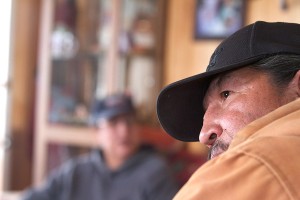
Clyde Home Gun, rancher and enrolled member of the Blackfeet tribe, opposes changing the enrollment policy. As a member of Blackfeet Against Open Enrollment, he feels letting descendants enroll would decrease tribal finances.
Kitty Bull Calf has long, straight black hair and a round face, telltale Blackfeet features, but her moss-green eyes give away her Irish heritage. Bull Calf is against changing the enrollment policy, and she said the controversy has divided the reservation and her family.
“Right now there’s really a separation,” she said. “It’s like an open wound that never should’ve been opened. They don’t realize what they’re doing to the reservation.”
Bull Calf has eight siblings, and many of her nieces and nephews aren’t enrolled. She said that while some of her family agrees with her about keeping blood quantum as a requirement for enrollment, others don’t even speak to her anymore.
“It tears people apart, like families,” she said. “This wound is going to take time, time to really heal. And it’s sad.”
Many families on the reservation are split between enrolled and un-enrolled members. Hall’s son-in-law isn’t enrolled even though all of his siblings are, because he was born right after the 1962 cutoff date for enrollment through descent.
Gabe Grant, a former council member who opposes the enrollment change, has been following the issue since it began. He keeps huge stacks of newspaper clippings, official documents and letters in large plastic bins in his back room and garage, all of which have to do with enrollment reform and blood quantum.
Grant emphasized that he and the other group members hold no animosity toward supporters of enrollment change or from other ethnic backgrounds. He said one reason the group favors blood quantum as an enrollment requirement is to ensure Blackfeet DNA will not disappear through marriages outside the tribe. He is afraid that without a blood-quantum measure, the genetic traits making Blackfeet people different from other ethnic groups will disappear.
“We’re unique,” Grant said. “We want to maintain that uniqueness. We’re proud of who we are. We’re proud of our history. We want to keep Blackfeet going forever.”
Grant and others who oppose the lineal descent system of enrollment claim the only way to keep Blackfeet blood from disappearing is to urge Blackfeet to marry other members of the tribe.
Calftail remembers his parents explaining blood quantum to him and his siblings when they were younger and encouraging them to marry into the tribe.
But the distinction may not be so clear. Even though both of Robert Hall’s parents support changing the enrollment policy and are enrolled, he isn’t. They were born before 1962, and were enrolled before blood quantum was a requirement.
Blackfeet blood quantum is measured in 64ths. Robert Hall (a cousin of Truman Hall) is 15/64ths Blackfeet, which puts him 1/64th under the amount he would need to be enrolled. The math is complicated, Robert Hall said, but basically each parent contributes half of their own blood quantum to their children.
For instance, a child would need at least 16 “points” to be considered a Blackfeet tribal member. Robert Hall automatically passes 7.5 points—half of the 15 points passed down by his parents—to his child. That means he would have to find a wife who could contribute at least 8.5 points for the child to be enrolled.
Truman Hall sees the blood quantum system as the tribe dictating who people should marry.
“They say don’t marry for love. They marry some lady because she’s got an enrollment number. Marry for rights,” he said. “Well, that’s pretty unfair in this day and age to have to breed human beings like you would breed quarter horses.
Since Fenner, Hall’s grandson, is not enrolled, there are some privileges tribal members can claim that he can’t, such as per capita payments, employment preferences, protection under the Indian Child Welfare Act, and Contract Health Service from the Indian Health Service, which sends patients off the reservation for specialty treatment.
On the other hand, non-enrolled Native Americans can still receive payment from lawsuits against the federal government, such as the Cobell and Salazar settlements, if they have an Individual Indian Money account with the BIA.
But what supporters of enrollment reform want most for descendants of the tribe is the right to vote.
Troy Woodward is an attorney living in Washington, D.C., who has been helping the Blackfeet Enrollment Amendment Reform group deal with the legal process of petitioning to change enrollment. He called enrollment a political issue in which descendants of the tribe have lost their political rights.
“We should be able to vote in elections, and we should be able to have a say about what happens to land that we inherit, and we should be able to pass our trust land that we inherit from our Indian parents to our Indian kids,” Woodward said. “And all of that has been taken away from us.”
Grant, one of the main opponents of enrollment reform, said the biggest benefit to being enrolled is the right to vote.
“That’s what we don’t want to give them, because there’s such a large number that they would take over the thinking and the way they view things, bringing in their values that they have,” he said. “Everything that the Blackfeet stood for—that would change with the large enrollment number.”
More than 100,000 people claimed to be at least partially Blackfeet on the 2010 census. Grant said the large number of people who could potentially enroll would overrun the services on the reservation, such as housing or Contract Health Service through the IHS.
Councilman Running Crane said if the enrollment policy changed, some programs, like IHS, might end up paying for health care for people off the reservation who could become enrolled under a lineal descent model.
There are about 40 programs on the reservation that receive funding based on tribal enrollment numbers, including Head Start, Fish and Wildlife programs, several in forestry and wildfire work, and some health programs, Running Crane said. As for grant-funded programs, the tribe would have to re-apply after updating numbers in the grant request applications. That funding wouldn’t automatically increase with a change in enrollment.
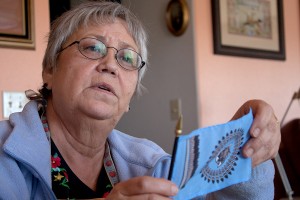
Linda Juneau holds up a small replica of the Blackfeet tribe’s flag during a Blackfeet Enrollment Amendment Reform meeting. The group has been banned from using tribal facilities to meet, so they hold their meetings at a member’s home.
Linda Juneau, the spokesperson to the BIA for the Blackfeet Enrollment Amendment Reform group, isn’t worried about being suddenly overrun with new tribal members. She said the enrollment reform group expects closer to 7,000 people would enroll under the lineal descent policy. She also said just because someone claims Blackfeet descent it doesn’t mean they can prove their parents, grandparents or great-grandparents were enrolled members.
The lineal descent model doesn’t stop after all the current descendants are enrolled. The grandchildren of a person who is enrolled as a descendant might end up with very little Blackfeet blood at all and would still be enrolled because their grandparent was.
According to its Indian Health Manual, IHS reviews different parameters that demonstrate need. Among them is population, along with quality of care and overall health in the area. If an increase in enrollment means an increase in the population of the reservation, then those funds might increase as well, but it’s not guaranteed. And it would mean that Blackfeet Community Hospital would also have to treat more people, creating a potential strain on an already underfunded health program.
The tribe could try to show a greater need for funding through a direct conversation with the IHS once enrollment changes, but nothing is guaranteed.
Since the Blackfeet reservation’s education system is part of the larger public school system in Montana, the schools don’t receive funding from the BIA. Instead, funds are distributed based on the number of students attending the school, whether or not they are enrolled tribal members or even Native American.
The superintendent of the Browning Public School District, Mary Johnson, said only the Johnson O’Malley Fund could be affected by the number of tribally enrolled students at the school. That grant is sent to the tribal council, which can then distribute it to schools in the area.
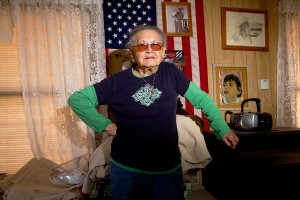
Omie Crawford is an enrolled member of the Blackfeet tribe and lives in Heart Butte. She is a supporter of the Blackfeet Enrollment Amendment Reform group and wants the enrollment requirements to change from blood quantum to lineal descent.
Woodward, the attorney working with the Blackfeet Enrollment Amendment Reform group, said they have to collect signatures from two-thirds of the tribally enrolled members for the petition to hold a vote to be accepted by the BIAW. The group estimates it will have to collect around 4,300 signatures.
Once the signatures, all of which have to be notarized, have been collected, the petition will be sent to the BIA and put on public display for 15 days. If anyone wanted to challenge a signature or claim that a non-enrolled member was carrying the petition (which is against the regulations), the public presentation time would be the time to do it, Woodward said.
The BIA would then mail out a voter registration form to all enrolled members of the tribe. Those members who respond will then receive a ballot to vote on whether to keep the enrollment policy the way it is or to change it to a system of lineal descent for up to three generations, as stated in the petition.
Those opposed to changing the enrollment policy recognize that someday there may not be enough Blackfeet members to continue using blood quantum as a measure of enrollment. Grant said the group thinks certain things will have to happen before the issue can be put to a vote.
First, he said, the standard of living for Blackfeet members living in poverty needs to be improved so they can think clearly about the policy change and its possible outcomes. Second, an enrollment audit would have to be done to correct any mistakes or fraud that might have taken place in the records of enrollment and blood quantum. Lastly, an outside group would have to conduct a study to see exactly how many people would enroll under the new system and what it would mean legally and financially for the tribe.
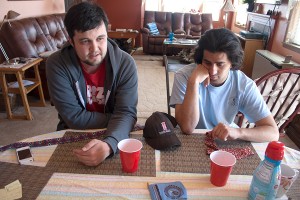
Sterling Holy White Mountain, left, and Robert Hall discuss why it is necessary to change the tribal enrollment policy. Both men are descendants of the Blackfeet tribe and active members of the Blackfeet Enrollment Amendment Reform group. If enrollment requirements change from blood quantum to lineal descent then both will be eligible for enrollment.
Truman Hall thinks the tribe should put the issue to a vote so the people can decide and hopes they would decide to enroll descendants. He said his grandson’s entire livelihood depends on changing the enrollment policy.
“[Fenner is] focused on making his living with ranching,” he said. “But in order to ranch you have to have control of real estate. And by not being enrolled, he doesn’t have any control of real estate at all. He has to do what the politicians tell him to do.”
Fenner went to school in Cut Bank, just outside the reservation borders, before he moved back in with his grandparents on the reservation.
Hall said Fenner got into fistfights nearly every day there, because “the white population in Cut Bank was prejudiced against him for being an Indian.” Now that he’s older, Hall said, Fenner is facing the same type of prejudice from his own people.
“If I pass on, he’s got no home here.”
 Native News Project 2013
Native News Project 2013